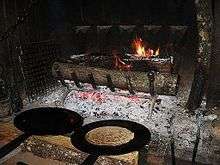Neccio
The Neccio (plural:Necci), also called Niccio, Ciaccio or Cian is a galette made with chestnut flour, typical of some mountain zones of Tuscany and Emilia, in Italy, and of the island of Corsica, in France.

Today people tend to consider the neccio as a dessert, but peasants once used to eat it with salty food.[1]
The Neccio has been declared a by the Italian government a Prodotto agroalimentare tradizionale ("traditional Italian regional food") of Tuscany.[1][2]
Distribution
The Neccio is typical of Pescia and the Pistoia Mountains, the Lucchesia, the upper Versilia, the Garfagnana, the Frignano and the upper Reno valley.[1] It is also prepared in the French island of Corsica.[1]
Denominations
In Garfagnana, a region of Tuscany, "neccio" is a term that designates the chestnut nut[3] and its derivatives.
Other names used for the necci are ciacci (in Versilia, upper Garfagnana and Frignano),[4] cian (in Lunigiana),[5] caccìn (in the province of La Spezia),[1] panèlle (Sestri Levante and surroundings),[1] castagnacci or patolle (having a more consistent dough)[1] or nicci (in Corsica).[6]
Preparation

The dough is made of chestnut flour, water and little salt.[7] In the Pistoia area chestnut flour is stored in special chestnut wood containers, called bigonce or bugni, or in wooden crates called arconi, from which the flour is taken in flakes and placed on sieves, chopping it with the hands.[2] The cooking is difficult and requires both a considerable expertise and either special disks, called testi, made of sandstone quenched with fire, to be put on the fireplace fire,[7][8] or the ferri or forme, iron discs with long handles which must be placed on the surface of the wood stove.[1] Today the testi are more used on the Bolognese side of the Apennines, while on the Pistoia Mountains the most used tools are the ferri.[1]
The cooking with the testi is particularly complex: chestnut leaves are harvested in summer during waning moon and left to soak in lukewarm water.[2] As soon as the testi have been heated, three to four leaves are laid on a testo, then a ladle of dough is put on them, then three to four more leaves and another hot testo, and so on, until a pile (named "castellina") is formed.[8][9] In this way the neccio does not stick to the testo and takes aroma and taste from the leaves.[2] The pile is contained by an iron text holder tool so that the pile did not fall down.[8] Usually one would pile up one of more rows of testi for 10-20 necci per row with decreasing diameter from bottom to top.[8][2] After two-three minutes the necci are ready and the pile is dismounted. [8][2]
Stuffed Necci

After cooking, the necci are generally stuffed with ricotta cheese (sometimes enriched with dark chocolate chips and/or candied fruit) and rolled up to take the shape of a cannolo.[1]
The neccio can be consumed:
- a biuscio, a dialectal term that stands for "without seasoning";[1]
- guercio ("one-eyed" in Italian), with the addition of a thin slice of pancetta before cooking or as a filling.[10] In the second case a few round slices of Tuscan Rigatino (a salumi akin to pancetta) can also be used.[1] They are typical of the Bolognese Mountains; [11]
- incicciato ("with meat" in Tuscan dialect), with the addition of salsiccia paste, used as filling or directly in the dough.[1] This version is typical of the Pistoia Mountains and in particular of the village of Pracchia;[1]
- con nutella, stuffed with plenty of chocolate cream. This is a non-traditional version, but appreciated especially among young people;[1]
- con ricotta cheese, with the addition of sheep or cow ricotta.[1] This variant is often used in the area of the Pistoia Apennines;[12]
- con stracchino cheese, with the addition of stracchino, typical of Lunigiana;[5]
References
- "I necci" (in Italian). Pesciantica. Retrieved 1 August 2020.
- "Neccio toscano". Prodotti Agroalimentari Tradizionali della Toscana (in Italian). Regione Toscana - Agricoltura. Retrieved 14 August 2020.
- "Farina di Neccio della Garfagnana: tradizione millenaria". ilgiornaledelcibo.it (in Italian). Retrieved 16 August 2020.
- "Ricette tipiche - i ciacci di castagne" (in Italian). Comune di Fanano. Retrieved 1 August 2020.
- "I cian della Lunigiana" (in Italian). Associazione Operatori Turistici della Lunigiana. Retrieved 16 August 2020.
- Schapira (1994) p. 107
- "I Necci" (in Italian). Museo del Castagno. Retrieved 1 August 2020.
- Alberto Gherardi (7 June 2007). "Vita rurale in Valdinievole" (in Italian). Retrieved 14 August 2020.
- "Come si facevano i necci di castagne nei tempi passati" (in Italian). Lucca italian school. 16 January 2011. Retrieved 14 August 2020.
- "Neccio guercio" (in Italian). CASA BONI—Comune di Granaglione (BO). Retrieved 1 August 2020.
- "Necci della montagna pistoiese" (in Italian). Retrieved 14 August 2020.
- Giovanni Capecchi (2008). Guida letteraria della montagna pistoiese (in Italian). Pistoia: Gli Ori. ISBN 978-88-7336-328-6.
Sources
- Schapira, Christiane (1994). La bonne cuisine corse (in French). Paris: Solar. ISBN 2263001778.
External links
| Wikimedia Commons has media related to Neccio. |